- Jan 6, 2021
5 Must-Have Trout Lures for Any Season
With so many lures to choose from, making the best selections can be challenging. These five trout fishing lures provide the tools for success in a vast range of fishing scenarios.
Trout streams range from tiny, tumbling mountain creeks to vast tailwater flows, with wide variances in habitat, stream conditions, forage sources and more. Consequently, there’s no “one size fits all” trout fishing lure. That’s said, you don’t need to carry everything but the kitchen sink as you wade up a stream. You just need to carry the right lures to provide solid options.
With that in mind, we’ve hand-picked a handful of highly effective trout fishing lures that all fill different niches and that collectively provide a complete arsenal for success in trout streams of all sizes.
Rebel Teeny Wee-Crawfish
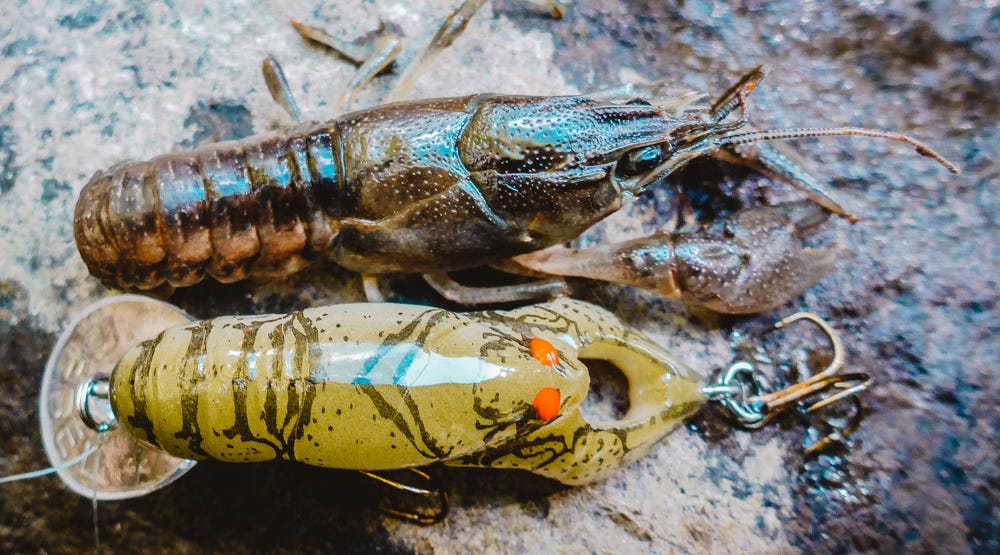

A Rebel Crawfish offers cast-crank-catch simplicity and an extremely natural match for a highly favored food source of trout everywhere. In truth, the entire Rebel Crawfish series has virtue, but forced to pick one, the Teeny Wee-Crawfish is arguably the best overall trout fishing lure in the series because of its 1 ½-inch size and performance in and out of current.
A Teeny Wee Crawfish can be cranked down in pools, but you can also crawl it across shallow gravel or sand so it digs like a foraging crawfish. It has a wide kick, moving a lot of water and offering excellent visibility for its size, but it’s also highly natural in its detailed shaping and coloring. The tucked claw design mimics a crawfish in its most vulnerable position.
You can add occasional twitches or pauses, but generally the best results come from casting this lure to or just past key targets and reeling it back steadily at a moderate pace. The Teeny Wee-Craw’s built-in action and appearance do the rest.
Lindy Quiver Spoon
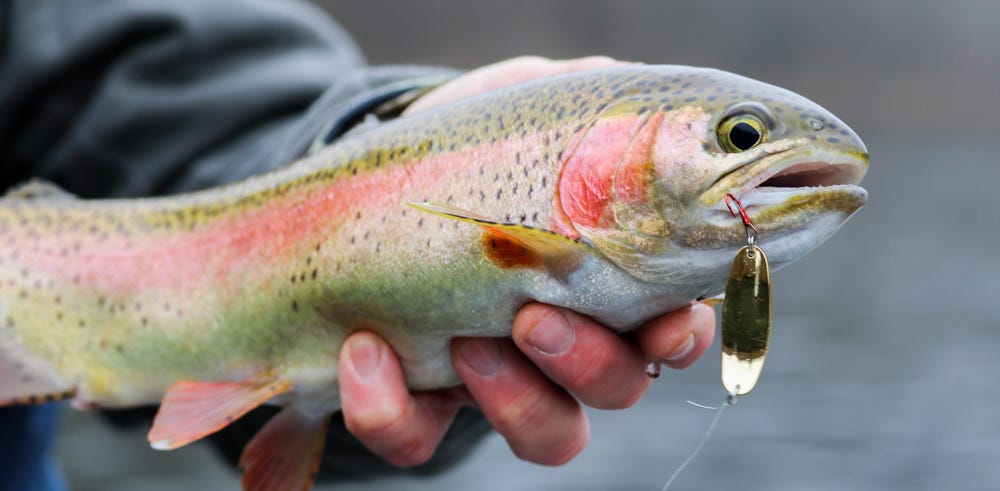

The Lindy Quiver Spoon was actually developed for ice fishing, but we don’t need to tell that to the stream trout. It is a lightweight spoon, with a slow fluttering fall, which makes it an ideal trout fishing lure for making natural subtle presentations but still sending out a lot of flash. The Quiver Spoon is also narrow, matching many kinds of natural forage and offering the appearance of an easy meal.
The Quiver Spoon comes in 1/16-, 1/8- and ¼-ounce sizes. The middle size, which measures 1 1/2 inches, fits the broadest range of situations, but the smallest one provides a great option for small streams and low flows, while the larger one provides a bit of extra casting distance and suggests a bigger meal for larger streams and heavier flows and for targeting larger trout.
Orient most Quiver Spoon casts upstream to minimize current resistance and allow the bait to sink freely. Let it fall to near the bottom (watching and feeling for strikes on the initial fall), and then work it with gentle twitches, lifts and drops or a mostly steady retrieve with occasional quick pauses. Vary presentations and let the trout dictate how they want your Quiver Spoon delivered.
Rebel Tracdown Ghost Minnow
A slow sinker, a Tracdown Ghost Minnow can be fished effectively across the tops of shallow shoals or near the bottom in deep pools. The extra weight that makes this lure sink also allows it to manage current far better than most minnow-style lures and to be cast with surprising ease.
The Tracdown Ghost Minnow has a slender profile that screams easy meal and enticing natural finishes in trout and baitfish patterns. The magic lies in its action and versatility, though. A steady retrieve creates a tight rolling wiggle trout can’t resist even when bluebird skies, extra-clear water or heavy fishing pressure makes them fussy. Twitching the rod tip prompts erratic darts and rolls.
Experiment with slow, straight retrieves, faster cranking, occasional slight twitches, series of harder jerks broken by pauses… and pay attention to what draws followers and, more importantly, prompts strikes.
Also try working different levels of the water column. Working with the current, pausing, holding your rod low and slowing your overall retrieve allow you to work deeper, with opposite actions keeping the bait higher in the water column.
Tasmanian devil
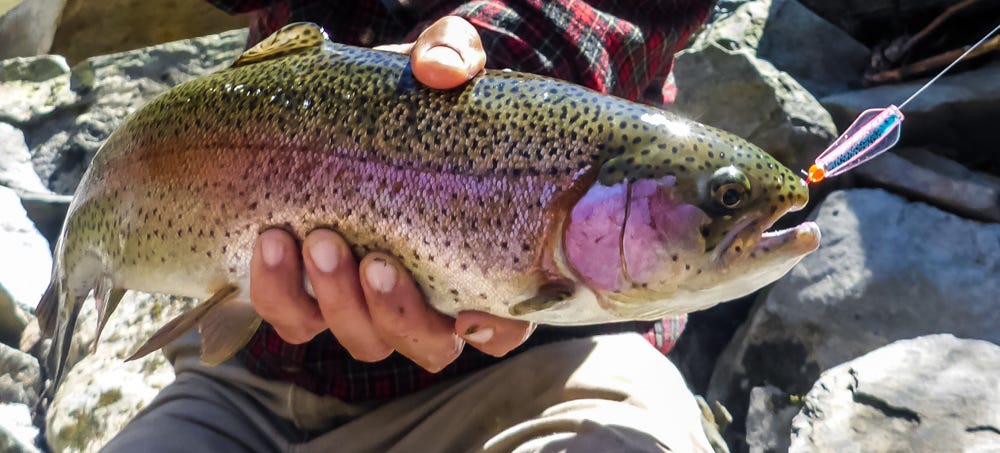

Developed in Australia and used mostly for trout trolling in lakes, Tasmanian Devils might not be familiar to you, and they look different than most other lures. They are dynamite trout catchers, though, that are easy to cast and create a lot of vibration as they come through the water, making them extra good for larger water, heavy flows and waters that carry a bit of stain.
A Tasmanian Devil has no hooks attached to it. It is built around a tube, and you run your line from end to end, add a provided bead and then tie your hook to the end of the line. The lure comes with a treble hook, which is sized right for the job, but you can use a single hook, barbless hook or some other style if you prefer.
When reeled, a Tassie wobbles erratically. Paused, it sinks and flutters toward the bottom. It can be cast upstream or cross current and swam steadily or worked with pulls and pauses. With the latter, fish often will hit on the pause, as the lure is fluttering down. A great approach for strong current is to cast cross current and reel very slowly or even just hold the rod up, with the line tight, allowing the Tasmanian Devil to dance as it fights the current and swings across and downstream.
Lindy Little Nipper
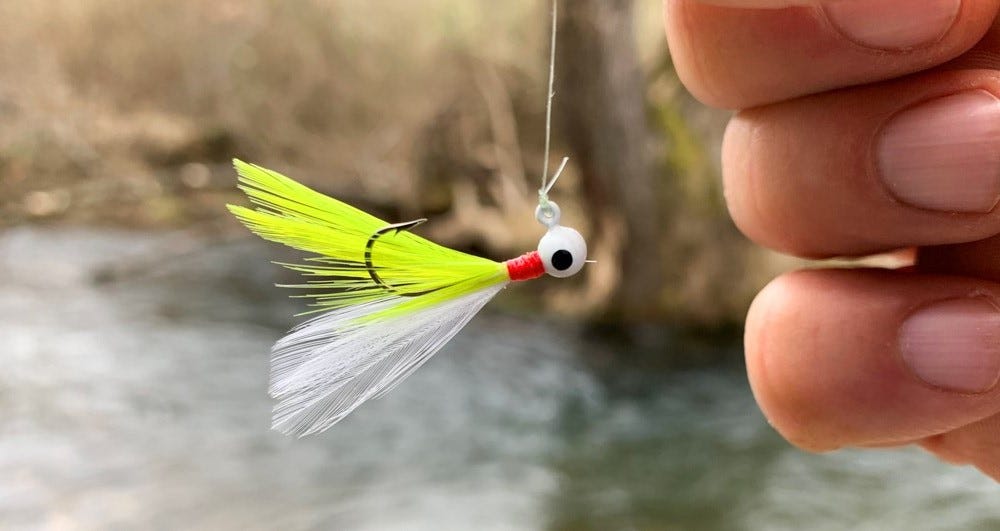

In striking contrast to the bold Tasmanian Devil, a Little Nipper provides the finesse element that needs to be in every trout box. Its offers a slender profile that suggests everything from a small minnow to caddis larvae and looks like a very easy meal. Its marabou fibers moves subtly, but also constantly, suggesting life and making this jig irresistible.
The Little Nipper comes in three sizes (1/16-ounce, 1/32-once, 1/64-ounce) and eight colors, all of which are good options for trout. The largest size has the fastest sink rate and is best suited for deep water and strong current because it does a better job of getting down to where the trout spend the most time. The 1/64-ounce is fabulous for extreme finesse, but it needs to be fished on ultralight gear with very light line for reasonable casting, unless you drift it under a float or fish two Little Nippers in a tandem rig.
Little Nippers can be cast on their own and worked with the current, reeling just enough to keep the line semi tight and using lifts or the rod tip to keep the bait off the bottom and add a lifting and falling motion. A great alternative is to add a small float like a Thill Oval Shorty style and dead drift the rig, much like a fly fisherman drifts a nymph beneath a strike indicator.
5 Tips for Trout Stream Success
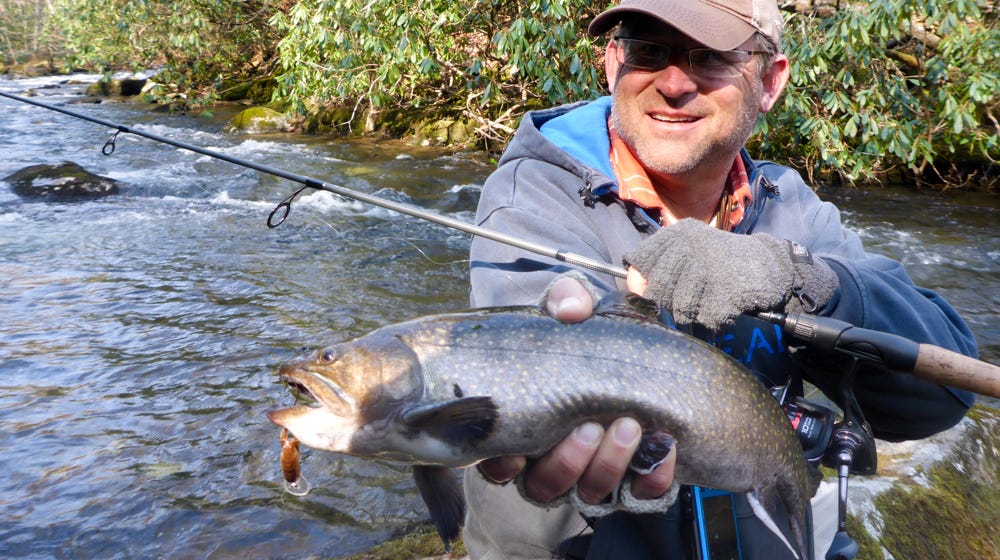

- Stay Stealthy – You’re far more likely to catch a trout that has not become aware of your presence. Work from stream edges when possible, use natural cover for concealment, and avoid abrupt movements.
- Surprise the Trout – Anytime rocks, brush or other cover create current breaks and trout hiding spots, plan a presentation that allows a fish’s first look at your lure to occur as it passes tight to that cover – and be ready!
- Consider Current – Stream current positions trout (facing up-current) and delivers food. Always consider current, including backward current lines in back eddies, and plan your casts and presentations to naturally put dinner in front of the trout.
- Study Stream Forage – Crawfish claws, aquatic insect hulls, critters and small fish you might spot all provide important clues about likely feeding behavior for trout and forage size and color, but they only help if you’re intentional about paying attention and applying what you learn.
- Repeat Successful Casts – Trout feed in specific spots because conditions are right, so where one fish bites, others are apt to be holding. Duplicate successful casts before even changing the angle or presentation.
Trout Lures
Teeny Wee-Crawfish, Color Recommendations: Stream Crawfish, Ditch Brown
Quiver Spoon – Color Recommendations: Gold, Pink Glow Gold
Tracdown Ghost Minnow, Color Recommendations: Rainbow Trout, Tennessee Shad
Tasmanian Devil, Color Recommendations: Brown Trout, Spotted Rainbow
Little Nipper, Color Recommendations: Black, Chartreuse Glow
More Trout Insights
Top Tailwaters for Trout Fishing



